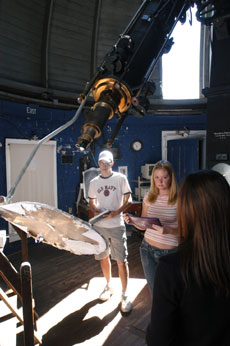Observatory stands as a hidden artifact

Tim Eggerding
October 1, 2004
Doug Peltz, a member of the Astronomical Society at the University of Illinois (UIAS), says students often have a hard time recognizing the function of the wooden-domed building west of the Morrow Plots. He said some students mistakenly believe that it is a mosque, only to be more confused when the dome begins to rotate.
The building is actually the University Observatory, which was built in 1896. According to the Department of Astronomy’s Web site, it was designated a National Historic Landmark by the Department of the Interior in 1989. Its wooden dome has never been replaced in the observatory’s history, but it has required minor repairs.
Peltz, a graduate student, said the observatory houses an ancient 12-inch refracting telescope that is still in operation today. The telescope is built straight into the bedrock and has no true physical connection to the observatory building in order to prevent interference of vibrations emanating from the building.
Peltz said the observatory’s telescope was fairly modest in comparison to other telescopes of its time.
“(The telescope) wasn’t constructed to peer into the depths of the universe,” Peltz said.
Get The Daily Illini in your inbox!
The telescope was mainly used for observatory astronomy, but Peltz said Joel Stebbins, who was the Observatory Director from 1903 to 1922, also used the telescope to develop telescope accessories.
Leslie Looney, assistant professor of the University’s Department of Astronomy, said the observatory played a crucial role in the history of astronomy. In 1912, astronomers at the Observatory became the first to measure the brightness of the stars using a photoelectric detector instead of relying on sight. Looney said this was the beginning of the “modern style of astronomy.”
However, as the astronomy department grew in size and the technology advanced, the observatory became obsolete for professional research purposes.
Peltz said the emergence of radio astronomy, which studies the universe through radio waves given off by stars, spelled the end of the observatory’s life as a research facility.
The last professional usage of the telescope occurred in 1967, when the double star RZ Cassiopeia was observed, according to the astronomy department’s Web site.
Bryan Dunne, a University graduate student and a teaching assistant for Astronomy 100, said Illinois is not the best place for astronomical research.
“Illinois is not the greatest location to build a telescope in,” he said. “Weather is not all that great, and we have a low elevation.”
Looney said the atmospheric turbulence in low altitudes, coupled with the light pollution on campus, adversely affects telescopic observations.
Dunne said the University has invested in several telescopes in California, a site he said was much better for observations due to the high altitude and dry weather.
However, the observatory is still considered an asset for the department because of its value in astronomy classes and introducing the general public to astronomy.
“(The observatory) is an excellent teaching tool,” Dunne said. “It’s used for non-astronomers who want to get to experience astronomy.”
Looney said the UIAS is a primary user of the observatory. He said the members of UIAS are given keys to the observatory to use the telescope, and receive training for its maintenance and usage.
Chris Hall, the observatory committee head of UIAS and senior in LAS, said the club holds an open house on the first Friday of every month, where those interested in looking at the stars can get a taste of observatory astronomy.
“They look up and wonder ‘What’s that in the sky?'” Hall said. “We give them the chance (to find out).”
Peltz said open houses are a good way to get people involved in astronomy.
“The more people you educate in astronomy, the more people you can have to share the enthusiasm,” he said.
Natalie Hepler, a University graduate student and teaching assistant for Astronomy 122, said every possible effort should be made to keep the observatory operational.
“Obviously it’s not top of the line, but it’s beautiful,” Hepler said. “It’s amazing (that) it’s over 100 years old and it’s still in operation.”






